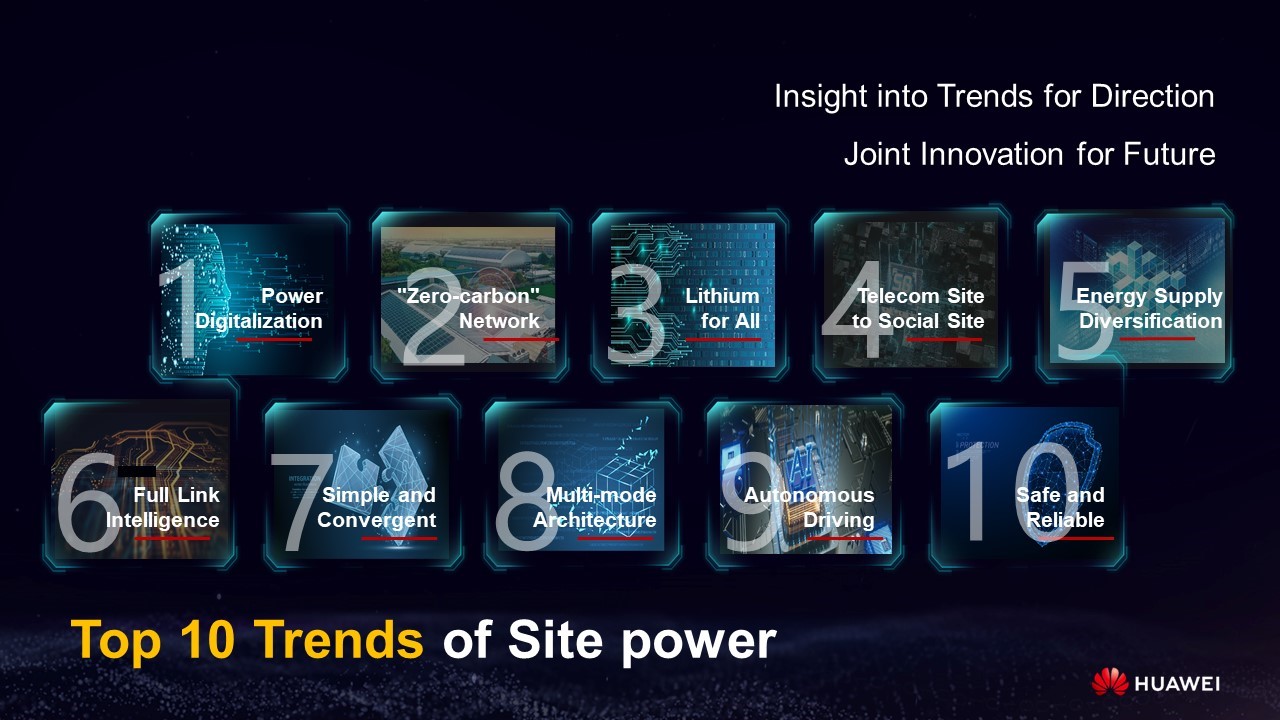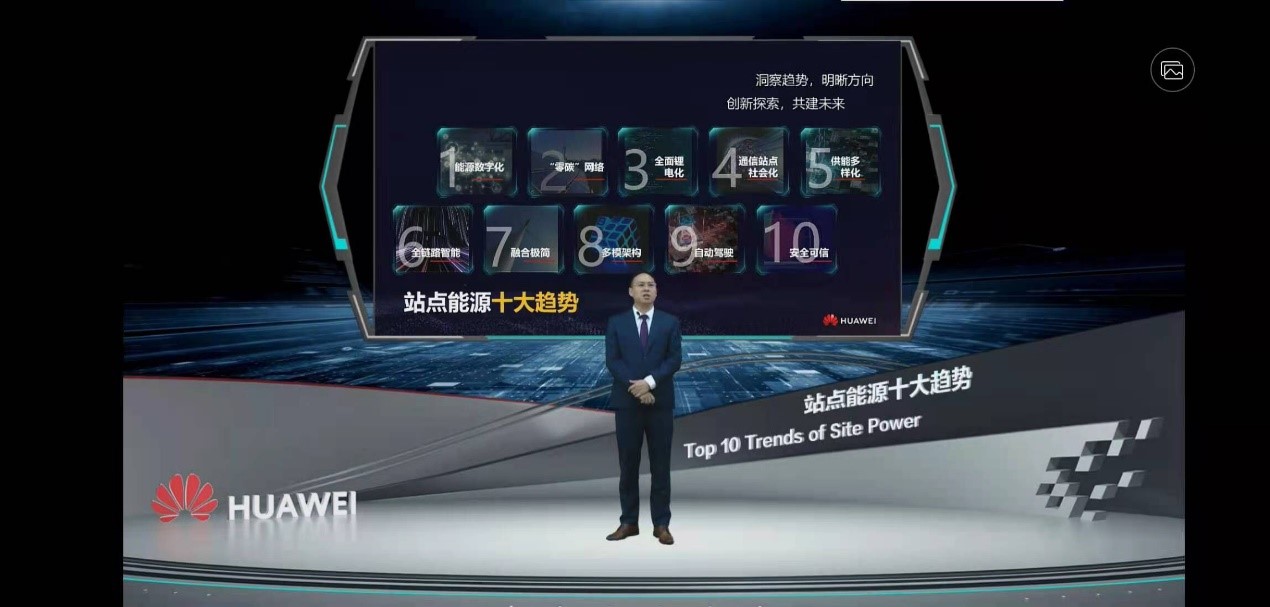Enterprise products, solutions & services
What will happen if the energy technologies are combined with the power electronics technologies and digital technologies? What does it mean to the site power?
To answer these questions, Peng Jianhua, President of Huawei Site Power Facility Domain, together with industry guests, discussed the technology and industry trends and predicted the ten trends in the site power domain. The ten trends are released to provide clues of development directions and innovation for the industry and help build a better future.

Ten trends of site power

Peng Jianhua, President of Huawei Site Power Facility Domain
The full power link from power generation, conversion, storage, to use will be digitalized. The entire energy network will change from the traditional watt flow to watt+bit collaboration, driving the digital transformation of site power from points, chains, and networks with the concept of Bit Manage Watt. The convergence of digital technologies and energy technologies will make energy networks visible, manageable, controllable, and optimizable.
To this end, Huawei explores a three-layer energy target network from the components, site, to network to help customers build a simple, intelligent, green, and reliable energy target network and meet the new energy development requirements in the future.
Green and sustainable development is a global campaign. Clean energy application and energy saving have become the mainstream around the world. In the future, the full link of power generation, load consumption, and power conversion and storage will be green, efficient, and energy-saving. From the top-level network planning and design, construction and capacity expansion, to the reconstruction and optimization, digital O&M and energy efficiency management, and zero-carbon evaluation, a zero-carbon network will be realized through the integration of power electronics, digital, and AI technologies. The rapid development of core technologies, high-efficiency technologies, and digital technologies also makes zero-carbon networks possible. Energy-related OPEX for carrier networks will not increase after adding 5G, greatly reducing CAPEX. Carbon emissions of networks will be cleared through simplified network construction, intelligent O&M, and full-lifecycle management of energy networks.
In Green Island, Greece, Huawei helps a carrier reduce carbon emissions by 10 tons per site per year by intelligent solar access. In Pakistan, Huawei uses advanced hybrid power supply to replace diesel generators, reducing carbon emissions by 18 tons per site per year.
Thanks to its long lifespan and continuous technology development, lithium batteries gradually replace lead-acid batteries in large-scale application in various industries around the world. Batteries that solely serve as emergency backup power can no longer meet diversified requirements in various scenarios. They are hoped to become a comprehensive energy supply. Common lithium batteries provide only a single function. After the power electronics and digital technologies are combined, the local BMS and cloud BMS will collaborate with each other. With the help of AI and big data technologies, common lithium batteries will become intelligent and cloud-based. From a single component to a cloud-based smart energy storage system, lithium batteries will be safer, applicable to more scenarios, and with more efficient O&M, maximizing the value of site energy storage.
Following the intelligent lithium battery, Huawei launched the fifth-generation CloudLi solution, which redefines the architecture of lithium batteries in the new era. The solution features full-scenario connection, simplified cloud maintenance, AI-based integrated energy storage, precise configuration, and proactive security management. This solution will sure bring more benefits to customers.
5G has entered different industries. As a result, a large number of digital sites are emerging. Varied scenarios require more flexible and diversified sites. Traditional sites with the single function of communication connection will evolve to social sites with comprehensive functions, maximizing the site value.
In Northern Africa, Huawei launched the innovative eMIMO solution, a unified energy platform that supports multiple input and output modes. This solution helps traditional site infrastructure with a single function transform to one with comprehensive energy services. Site power facilities also supply power to small-scale retail stores and police stations in villages.
The diversification of energy supply is embodied in three aspects: First, the diversification of power supply sources. New energy, especially solar energy, will gradually shift from supplementary to primary. In addition, more power supply solutions with optimal configurations will be available thanks to the combination of new energy with mains and energy storage system. Second, the diversification of application scenarios. Site power is no longer just the power source of IT or CT equipment. Instead, it changes to ICT converged power supply and begins to power people's livelihood and production. Third, the diversification of deployment modes. In the future, site power can be deployed in multiple modes. For example, centralized solar power plant, campus power supply and small-sized micro-grid power supply, distributed power supply and hybrid power supply, and household PV power supply. Power facility deployment will change from centralized to centralized+distributed mode to meet different application requirements.
In Ethiopia, Huawei used the advanced solar energy, energy storage, and diesel generator hybrid solution to save 12.26 million liters of fuel for communications sites, saving US$20,000 in fuel costs and reducing carbon emissions by 26.2 tons. In Nigeria, distributed off-grid micro power plants were used to reduce the cost per kWh from US$0.5 to US$0.2. The power system provides stable power supply for the local area around the clock.
With the gradual digital transformation of the energy industry, the traditional siloed architecture and isolated management of energy subsystems will evolve towards integrated smart energy. The software-defined subsystems for power generation, conversion, storage, distribution, consumption, and temperature control will use AI algorithms to achieve full-link collaboration and optimal power supply systems.
In Zhejiang province of China, Huawei cooperates with China Tower to reduce the site power consumption by 17.1% through the AI-based peak staggering function, helping the customer reduce the electricity fee by CNY1788 per site per year.
As a large number of sites will be deployed, IT and CT services are further integrated at one site and the power supply and battery will be combined. The AC and DC power modes are integrated in one power supply. Therefore, multiple power systems will become one. Sites will evolve from equipment rooms to cabinets and poles, reducing the footprint and power consumption. The site power efficiency will be further improved and the electricity fee will also decrease, achieving low carbon emission throughout the entire network and realizing simplified power supply during the lifecycle.
In Mexico, Huawei launched the iSuperSite solution, which supports ultra-high-density and large-capacity power supply and equipment housing. This solution uses cabinets to replace rooms and integrates IT and CT power supplies into one to reduce site deployment costs and shorten the deployment period. It can reduce power consumption and save rents, achieving optimal TCO.
With the diversification of energy supply and equipment types, site power will develop towards a multi-mode coordinated architecture. The system architecture will support multiple energy input and output modes, multi-mode scheduling control and management. The system will evolve by modular overlay. One power supply system applies to multiple scenarios and realizes converged power supply for different services and devices.
With Huawei's innovative and unified eMIMO power supply architecture, one power supply system (platform) supports multiple input and output modes, meeting the power requirements of different equipment in various industries such as communications, transportation, and electric power.
Autonomous driving is the development theme of site power in the future. First, the application of AI technologies will simplify energy O&M, implement remote O&M, self-learning, and automatic O&M, and improve O&M quality and efficiency. Second, the intelligent IoT connection technologies and intelligent sensing technologies will enable digital management of site power. The original management of dumb devices will be eliminated. With digital sensors and the intelligent management platform, all components and devices in the energy network can be sensed and interconnected.
In Zhejiang Province, Huawei uses the AI-powered intelligent load power-off slicing technology to ensure power supply to important services and ensure zero site breakdown during the epidemic. During the epidemic, the remote battery inspection function of Huawei intelligent sites reduces manual site visits. The battery test precision is also improved, reducing the site visit cost by US$200/year for a single site.
The surge of data volumes spurs the network, digital, and intelligent transformation in the energy industry. Therefore, the reliability, security, privacy, and resilience of hardware and software become necessary requirements.
Huawei's power products feature high security and reliability design of software and hardware. In addition to high-reliability design and manufacturing, predictive maintenance is supported at the hardware side to consolidate the reliable foundation. In terms of software, layered control and defense functions are added to software, making the energy industry more safe and reliable.

Online release of the top ten trends by Peng Jianhua
Deep insights into the industry trends help enterprises to better adapt to future challenges. By releasing the ten trends, Huawei Site Power aims to provide guidance for technology and industry development as well as industry digitization, help build a greener and better connected world, and bridge the energy divide. In the future, Huawei Site Power will continue to adhere to openness and cooperation and work with industry customers, partners, and third-party organizations to promote innovations and achieve win-win outcomes in the digital power era.